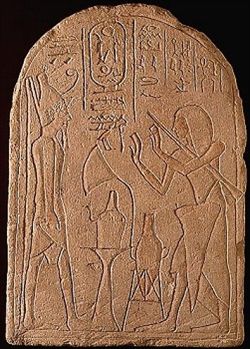
Memorial stone, usually rectangular or with a rounded upper edge, with representations and/or texts. The majority of the texts are funerary in character. The owner of the stela listed his names and titles so that they would live on, and often biographical information. Often there is also a request to the living to give offerings. Funerary stelae are known from as early as the Protodynastic period, the main aim of which was to record the name of the king, written in a serekh. Around the beginning of the Old Kingdom, this type was combined with the niche in which the stela stood, which eventually led to the creation of the false door. Egyptians ideally wanted to be buried in the sacred town of Abydos, or if that was not possible at least to have a cenotaph there. Even this was too expensive for most Egyptians, however, and thus they contented themselves with the erection of a stela in Abydos, near the temple of Osiris. The idea behind this was that then you were at least present in Abydos 'in name'. Another type of stela is the one inscribed with hymns to the gods. Among the best known examples of this type are those with hymns to the sun god and other gods found in the tomb of Horemheb at Saqqara. Votive stelae, mainly known from the Ramesside Period as an expression of 'personal piety', contain prayers of entreaty to the gods. The owner of the stela would confess his sins on it and praise the god's greatness in the hope of receiving healing. Sometimes these stelae include an illustration of the god's ear, 'which hears'. This type of stela was usually placed in or near a temple. Furthermore, there are memorial stelae on which, for example, the victories of the king over his enemies or other important events were recorded. Given that this usually happened on the orders of or on behalf of a god, this type of stela was also erected in temples as a type of votive stela. Well known examples include Tutankhamun's Restoration Stela, which revoked Akhenaten's religious policies, and Merenptah's Israel stela. Finally, there were also border stelae. These marked out the borders of Egypt, of a city such as Akhetaten, or of smaller areas. Stelae were nearly always made of stone, usually limestone. Examples in other materials are also known, for example wood covered in plaster which was then painted. An occasional stela of faience is also known.